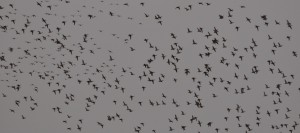Photography courtesy of Lowell Washburn, all rights reserved.
Monday morning, the final day of November. A significant winter storm was brewing and you could feel it in the air. A light skiff of snow had already fallen during the night and area weather forecasters were all but guaranteeing that more snow and maybe even some ice was headed our way. With more than an hour to go until daylight, school cancellations had mounted to the point that it would have been easier to announce which districts [if any] were planning to hold classes than to list those who weren’t.
Even though most North Iowa wetlands had been iced over for more than a week, there were still some ducks — mostly mallards — clinging to the open river channels or along the edge of big water air holes. With the current weather system building as it was, whatever waterfowl still remained were sure to be on the move.
All things considered, it seemed like a perfect day for a duck hunt. Since all the marshes I usually hunt were frozen tighter than a meat block, a trip to some nearby corn stubble seemed in order. When the barometer began its inevitable plunge, lingering flocks of mallards would suddenly feel as if they were in immediate danger of starvation. Ducks would be looking for high energy food sources which in North Iowa, means golden kernels of carbo charged waste grain.
Legal shooting time was set to commence at 6:55 am. The best waterfowl hunts are shared hunts; and although my son Matt had scheduled work activities, he would be able to hunt for the first thirty or forty minutes. Arriving at what we hoped would be an attractive field, we quickly set out a spread of mallard field shells along with four spinners. Our location proved to be a good choice. As it turned out, we never got to finish our first cup of morning coffee due to the pleasing fact that the first flock of mallards arrived within seconds of starting time. More than a hundred strong, the birds descended like fighter jets; their tightly cupped wings roaring in the dark overcast.
Although the birds came to under 15 yards on their first pass, neither of us rose to shoot — the swarm of ducks seemed too incredible. On their second swing, mallards began to bail from the flock and land beside the decoys. I had ducks landing to guzzle corn within scant feet of where I was laying, and Matt literally had an overhead drake hovering so close before landing that he probably could have made an attempt to grab the duck in midair. More flocks continued to appear out of the dark overcast until we found ourselves lying at the base of a genuine, late season ducknado! Mallards swirled like swarms of gnats in all directions and hens chattered noisily as more and more birds piled into the corn. It was a good place to be.
We both knew that the show wouldn’t last forever, and we finally did begin shooting at what appeared to be an endless supply of incoming flocks. The daily bag limit is four mallards per hunter, and within minutes we each had three ducks on the ground. There was almost never more than a minute or two when at least one flock of birds wasn’t working our decoys. We finally decided that whoever got the next clear shot at a drake should take it. We soon got our opportunity when a single drake bailed from an approaching flock and sailed all the way in, bringing at least 45 or 50 of his buddies with him. I pulled up on that bird and Matt found a second greenhead as the survivors flared away.
With our two man limit now in the bag, more and more mallards continued to arrive over the field. With over half of our allotted hunt time still remaining, it was time to finish off the thermos while continuing to watch the most incredible duck show of the 2015 season. Although we had expected to see some mallards, their total numbers had come as a complete surprise. I still haven’t figured out where all those hundreds of ducks came from, but I do know that we both felt blessed to have witnessed this breath taking, end-of-November event.
LW
Nov. 30, 2015





 Tom Cope
Tom Cope Sue Wilkinson
Sue Wilkinson Susan Judkins Josten
Susan Judkins Josten Rudi Roeslein
Rudi Roeslein Elyssa McFarland
Elyssa McFarland Mark Langgin
Mark Langgin Adam Janke
Adam Janke Joe Henry
Joe Henry Kristin Ashenbrenner
Kristin Ashenbrenner Joe Wilkinson
Joe Wilkinson Dr. Tammy Mildenstein
Dr. Tammy Mildenstein Sean McMahon
Sean McMahon